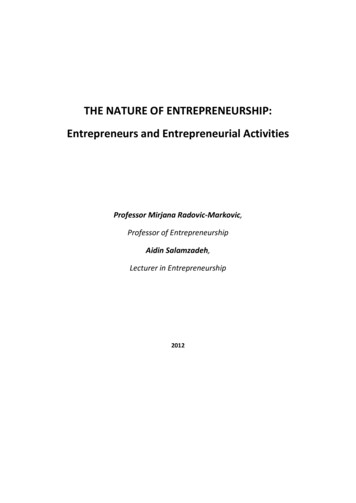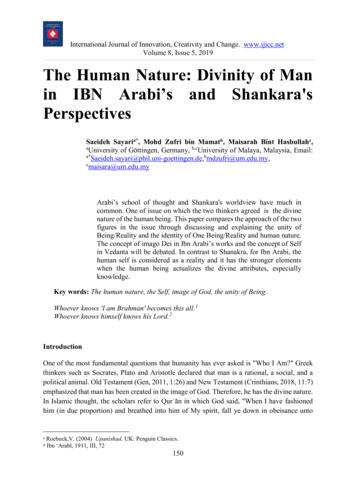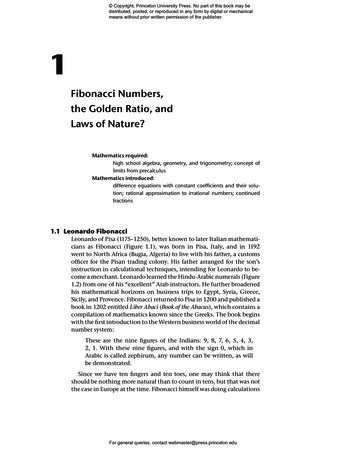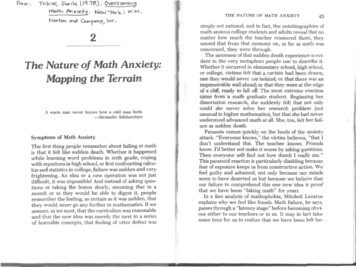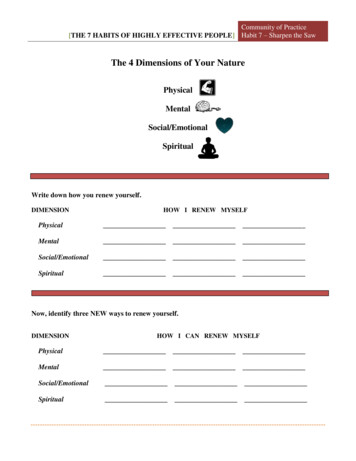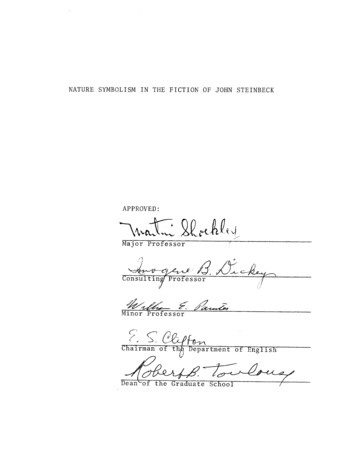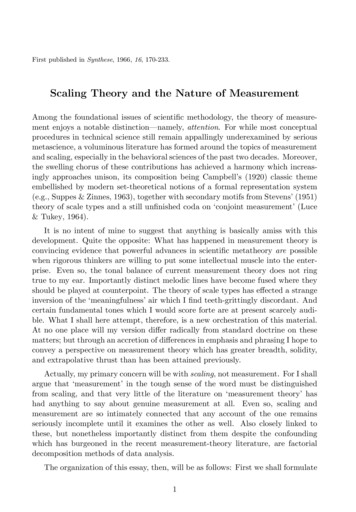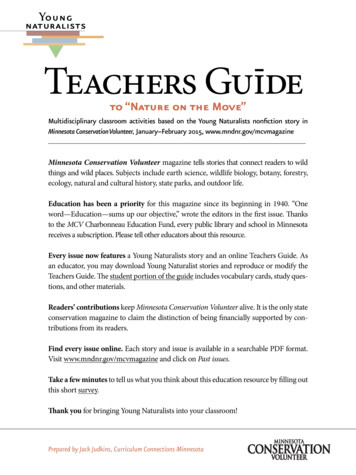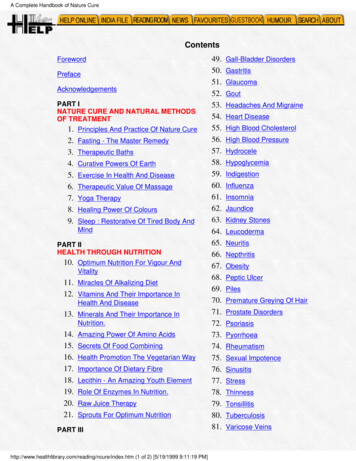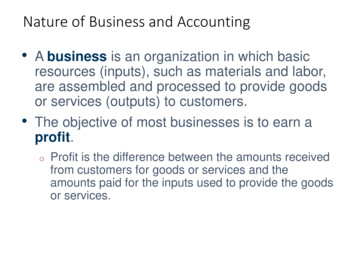
Transcription
Nature of Business and Accounting A business is an organization in which basicresources (inputs), such as materials and labor,are assembled and processed to provide goodsor services (outputs) to customers. The objective of most businesses is to earn aprofit.oProfit is the difference between the amounts receivedfrom customers for goods or services and theamounts paid for the inputs used to provide the goodsor services.
Role of Accounting in Business Accounting can be defined as an informationsystem that provides reports to users about theeconomic activities and condition of a business.
Managerial Accounting The area of accounting that provides internalusers, such as managers and employees, withinformation is called managerial accounting, ormanagement accounting. The objective of managerial accounting is toprovide relevant and timely information formanagers’ and employees’ decision-makingneeds. Managerial accountants employed by abusiness are employed in private accounting.
Financial Accounting The area of accounting that provides externalusers, such as investors, creditors, customers,and the government, with information is calledfinancial accounting. The objective of financial accounting is toprovide relevant and timely information for thedecision-making needs of users outside of thebusiness. General-purpose financial statements are onetype of financial accounting report that isdistributed to external users.
Role of Ethics in Accounting and Business(slide 1 of 2) The objective of accounting is to provide relevant, timelyinformation for user decision making. Accountants must behave in an ethical manner so thatthe information they provide users will be trustworthyand, thus, useful for decision making. Managers and employees must also behave in an ethicalmanner in managing and operating a business. Ethics are moral principles that guide the conduct ofindividuals.
Role of Ethics in Accounting and Business(slide 2 of 2) As a result of accounting and business frauds,Congress passed laws to monitor the behaviorof accounting and business, such as theSarbanes-Oxley Act (SOX).oSOX established a new oversight body for theaccounting profession called the Public CompanyAccounting Oversight Board (PCAOB).oIn addition, SOX established standards forindependence, corporate responsibility, anddisclosure.
Opportunities for Accountants Accountants employed by a business areemployed in private accounting. Accountants and their staff who provide serviceson a fee basis are said to be employed in publicaccounting.oIn public accounting, an accountant may practice asan individual or as a member of a public accountingfirm.oPublic accountants who have met a state’s education,experience, and examination requirements maybecome Certified Public Accountants (CPAs).
Generally AcceptedAccounting Principles (GAAP)(slide 1 of 2) Financial information in the United States isbased on generally accepted accountingprinciples (GAAP). GAAP is a collection of accounting standards,principles, and assumptions that define howfinancial information will be reported.oAccounting standards are the rules that determinethe accounting for individual business transactions.oAccounting principles and assumptions providethe framework upon which accounting standards areconstructed.
Generally AcceptedAccounting Principles (GAAP)(slide 2 of 2) Within the United States, the Financial AccountingStandards Board (FASB) has the primary responsibilityfor developing accounting principles. The Securities and Exchange Commission (SEC), anagency of the U.S. government, has authority over theaccounting and financial disclosures for companieswhose shares of ownership (stock) are traded and soldto the public. Outside the United States, most countries useaccounting standards and principles adopted by theInternational Accounting Standards Board (IASB).
Characteristics of Financial Information To be useful, financial reports must possess twoimportant characteristics: relevance and faithfulrepresentation.oRelevant information has the potential to impactdecision making.oFaithful representation means that the informationaccurately reflects an entity’s economic activity orcondition.
Assumptions(slide 1 of 5) Financial accounting and generally acceptedaccounting principles are based upon thefollowing assumptions:oMonetary unitoTime periodoBusiness entityoGoing concern
Assumptions(slide 2 of 5) The monetary unit assumption requires thatfinancial reports be expressed in a single moneyunit, or currency.oThis provides a common measurement of the effectsof economic events and transactions on an entity.oThe monetary unit used is normally determined by thecountry in which the company operates.
Assumptions(slide 3 of 5) The time period assumption allows a companyto report its economic activities on a regularbasis for a specific period of time.oIn doing so, financial condition and changes infinancial condition are reported periodically on aconsistent basis.
Assumptions(slide 4 of 5) The business entity assumption limits theeconomic data in financial reports to that directlyrelated to the activities of the business.oIn other words, the business is viewed as an entityseparate from its owners, creditors, or otherbusinesses.
Assumptions(slide 5 of 5) The going concern assumption requires thatfinancial reports be prepared assuming that theentity will continue operating into the future.
Principles(slide 1 of 5) The following four principles are an integral partof financial accounting:oMeasurementoHistorical costoRevenue recognitionoExpense recognition
Principles(slide 2 of 5) The measurement principle determines theamount that will be recorded and reported.oThe measurement principle requires that amounts beobjective and verifiable. An amount is objective if it is based upon independent,unbiased evidence. An amount is verifiable if it can be confirmed by a third party.oTransactions between two independent parties, calledarm’s-length transactions, provide amounts that areobjective and verifiable.
Principles(slide 3 of 5) Recording an item at its initial transaction priceis called the historical cost principle or costprinciple.
Principles(slide 4 of 5) Revenue is the amount earned for selling goodsor services to customers. The revenue recognition principle determineswhen revenue is recorded in the accountingrecords.oNormally, revenue is recorded when the serviceshave been performed or goods are delivered to thecustomer.
Principles(slide 5 of 5) Expenses are amounts used to generaterevenue. The expense recognition principle, sometimescalled the matching principle, requires expensesto be recorded in the same period as the relatedrevenue.oDoing so allows the reporting of a profit or loss for theperiod.
The Accounting Equation(slide 1 of 2) The resources owned by a business are itsassets. The rights of creditors are the debts of thebusiness and are called liabilities. The rights of owners are called equity.oSince stockholders own a corporation, equity is calledstockholders’ equity.oFor a proprietorship, partnership, or limited liabilitycompany, equity is called owner’s equity.
The Accounting Equation(slide 2 of 2) The following equation is called the accountingequation:Assets Liabilities Stockholders’ Equity Liabilities usually are shown before equity in theaccounting equation because creditors have firstrights to the assets.
Business Transactions andthe Accounting Equation An economic event or condition that directlychanges an entity’s financial condition or itsresults of operations is a business transaction. All business transactions can be stated in termsof changes in the elements of the accountingequation.
Transactions(slide 1 of 2) A corporation issues common stock to investors asproof of their ownership rights. The liability created by a purchase on account is calledan account payable. Items such as supplies that will be used in the businessin the future are called prepaid expenses, which areassets. A business earns money by selling goods or services toits customers. This amount is called revenue. Revenue from providing services is recorded as feesearned.
Transactions(slide 3 of 4) Revenue from the sale of merchandise is recorded assales. Other examples of revenue include rent, which isrecorded as rent revenue, and interest, which isrecorded as interest revenue. An account receivable is a claim against the customer,which is an asset. Assets used in the process of earning revenue are calledexpenses. Dividends are distributions of earnings to stockholders.
Classifications of Stockholders’ Equity(slide 1 of 2) Stockholders’ equity is classified as:oCommon StockoRetained Earnings
Classifications of Stockholders’ Equity(slide 2 of 2) Common stock is shares of ownershipdistributed to investors of a corporation.o It represents the portion of stockholders’ equitycontributed by investors.Retained earnings is the stockholders’ equitycreated from business operations throughrevenue and expense transactions.
Financial Statements After transactions have been recorded andsummarized, reports are prepared for users. Theaccounting reports providing this information arecalled financial statements. The primary financial statements of acorporation are the:oIncome statementoRetained earnings statementoBalance sheetoStatement of cash flows
Income Statement The income statement reports the revenues andexpenses for a period of time, based on therevenue and expense recognition principles.oThese principles match revenues and their relatedexpenses so that they are reported in the sameperiod. The excess of the revenue over the expenses iscalled net income, net profit, or earnings. If expenses exceed revenue, the excess is a netloss.
Retained Earnings Statement The retained earnings statement reports thechanges in the retained earnings for a period oftime. It is prepared after the income statementbecause the net income or net loss for theperiod must be reported in this statement. Similarly, it is prepared before the balance sheet,since the amount of retained earnings at the endof the period must be reported on the balancesheet.
Balance Sheet A balance sheet reports the amounts of assets,liabilities, and stockholders’ equity as of aspecific date. The report form presents a balance sheet in avertical form.
Statement of Cash Flows A statement of cash flows consists of thefollowing three sections:1.operating activities2.investing activities3.financing activities
Statement of Cash Flows:Cash Flows from Operating Activities The cash flows from operating activities sectionreports a summary of cash receipts and cashpayments from operations.
Statement of Cash Flows:Cash Flows from Investing Activities The cash flows from investing activities sectionreports the cash transactions for the acquisitionand sale of relatively permanent assets.
Statement of Cash Flows:Cash Flows from Financing Activities The cash flows from financing activities sectionreports the cash transactions related to cashinvestments by stockholders, borrowings, anddividends.
Analysis for Decision Making:Ratio of Liabilities to Stockholders’ Equity The ratio of liabilities to stockholders’ equityis useful in analyzing the ability of a company topay its creditors. The ratio of liabilities to stockholders’ equity iscomputed as follows:Ratio of Liabilities to Stockholders’ Equity Total LiabilitiesTotal Stockholders’ Equity
The monetary unit assumption requires that financial reports be expressed in a single money unit, or currency. o This provides a common measurement of the effects of economic events and transactions on an entity. o The monetary unit used is normally determined by the country in which the company operates. Assumptions (slide 3 of 5) The time period assumption allows a company to

